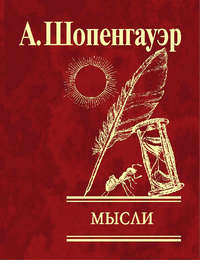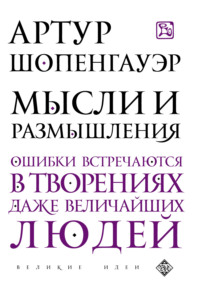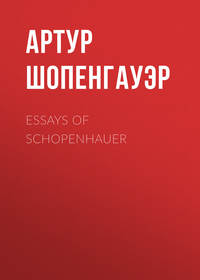 полная версия
полная версияThe World as Will and Idea (Vol. 3 of 3)
Now although, as was cursorily shown above, architecture has by no means to imitate the forms of nature, such as the stems of trees or even the human figure, yet it ought to work in the spirit of nature, for it makes the law its own, natura nihil agit frustra, nihilque supervacaneum, et quod commodissimum in omnibus suis operationibus sequitur, and accordingly avoids everything which is even only apparently aimless, and always attains the end in view in each case, whether this is purely architectonic, i. e., structural, or an end connected with usefulness, by the shortest and most natural path, and thus openly exhibits the end through the work itself. Thus it attains a certain grace, analogous to that which in living creatures consists in the ease and suitableness of every movement and position to its end. Accordingly we see in the good antique style of architecture every part, whether pillar, column, arch, entablature, or door, window, stair, or balcony, attain its end in the directest and simplest manner, at the same time displaying it openly and naively; just as organised nature also does in its works. The tasteless style of architecture, on the contrary, seeks in everything useless roundabout ways, and delights in caprices, thereby hits upon aimlessly broken and irregular entablatures, grouped columns, fragmentary cornices on door arches and gables, meaningless volutes, scrolls, and such like. It plays with the means of the art without understanding its aims, as children play with the tools of grown-up people. This was given above as the character of the bungler. Of this kind is every interruption of a straight line, every alteration in the sweep of a curve, without apparent end. On the other hand, it is also just that naive simplicity in the disclosure and attainment of the end, corresponding to the spirit in which nature works and fashions, that imparts such beauty and grace of form to antique pottery that it ever anew excites our wonder, because it contrasts so advantageously in original taste with our modern pottery, which bears the stamp of vulgarity, whether it is made of porcelain or common potter's clay. At the sight of the pottery and implements of the ancients we feel that if nature had wished to produce such things it would have done so in these forms. Since, then, we see that the beauty of architecture arises from the unconcealed exhibition of the ends, and the attainment of them by the shortest and most natural path, my theory here appears in direct contradiction with that of Kant, which places the nature of all beauty in an apparent design without an end.
The sole theme of architecture here set forth – support and burden – is so very simple, that just on this account this art, so far as it is a fine art (but not so far as it serves useful ends), is perfect and complete in essential matters, since the best Greek period, at least, is not susceptible of any important enrichment. On the other hand, the modern architect cannot noticeably depart from the rules and patterns of the ancients without already being on the path of deterioration. Therefore there remains nothing for him to do but to apply the art transmitted to him by the ancients, and carry out the rules so far as is possible under the limitations which are inevitably laid down for him by wants, climate, age, and country. For in this art, as in sculpture, the effort after the ideal unites with the imitation of the ancients.
I scarcely need to remind the reader that in all these considerations I have had in view antique architecture alone, and not the so-called Gothic style, which is of Saracen origin, and was introduced by the Goths in Spain to the rest of Europe. Perhaps a certain beauty of its own kind is not altogether to be denied to this style, but yet if it attempts to oppose itself to the former as its equal, then this is a barbarous presumption which must not be allowed for a moment. How beneficently, after contemplating such Gothic magnificence, does the sight of a building correctly carried out in the antique style act upon our mind! We feel at once that this alone is right and true. If one could bring an ancient Greek before our most celebrated Gothic cathedrals, what would he say to them? – Βαρβαροι! Our pleasure in Gothic works certainly depends for the most part upon the association of ideas and historical reminiscences, thus upon a feeling which is foreign to art. All that I have said of the true æsthetic end, of the spirit and the theme of architecture, loses in the case of these works its validity. For the freely lying entablature has vanished, and with it the columns: support and burden, arranged and distributed in order to give visible form to the conflict between rigidity and gravity, are here no longer the theme. Moreover, that thorough, pure rationality by virtue of which everything admits of strict account, nay, already presents it of its own accord to the thoughtful beholder, and which belongs to the character of antique architecture, can here no longer be found; we soon become conscious that here, instead of it, a will guided by other conceptions has moved; therefore much remains unexplained to us. For only the antique style of architecture is conceived in a purely objective spirit; the Gothic style is more in the subjective spirit. Yet as we have recognised the peculiar æsthetic fundamental thought of antique architecture in the unfolding of the conflict between rigidity and gravity, if we wish to discover in Gothic architecture also an analogous fundamental thought, it will be this, that here the entire overcoming and conquest of gravity by rigidity is supposed to be exhibited. For in accordance with this the horizontal line which is that of burden has entirely vanished, and the action of gravity only appears indirectly, disguised in arches and vaults, while the vertical line which is that of support, alone prevails, and makes palpable to the senses the victorious action of rigidity, in excessively high buttresses, towers, turrets, and pinnacles without number which rise unencumbered on high. While in antique architecture the tendency and pressure from above downwards is just as well represented and exhibited as that from below upwards, here the latter decidedly predominates; whence that analogy often observed with the crystal, whose crystallisation also takes place with the overcoming of gravity. If now we attribute this spirit and fundamental thought to Gothic architecture, and would like thereby to set it up as the equally justified antithesis of antique architecture, we must remember that the conflict between rigidity and gravity, which the antique architecture so openly and naïvely expresses, is an actual and true conflict founded in nature; the entire overcoming of gravity by rigidity, on the contrary, remains a mere appearance, a fiction accredited by illusion. Every one will easily be able to see clearly how from the fundamental thought given here, and the peculiarities of Gothic architecture noticed above, there arises that mysterious and hyperphysical character which is attributed to it. It principally arises, as was already mentioned, from the fact that here the arbitrary has taken the place of the purely rational, which makes itself known as the thorough adaptation of the means to the end. The many things that are really aimless, but yet are so carefully perfected, raise the assumption of unknown, unfathomed, and secret ends, i. e., give the appearance of mystery. On the other hand, the brilliant side of Gothic churches is the interior; because here the effect of the groined vaulting borne by slender, crystalline, aspiring pillars, raised high aloft, and, all burden having disappeared, promising eternal security, impresses the mind; while most of the faults which have been mentioned lie upon the outside. In antique buildings the external side is the most advantageous, because there we see better the support and the burden; in the interior, on the other hand, the flat roof always retains something depressing and prosaic. For the most part, also, in the temples of the ancients, while the outworks were many and great, the interior proper was small. An appearance of sublimity is gained from the hemispherical vault of a cupola, as in the Pantheon, of which, therefore, the Italians also, building in this style, have made a most extensive use. What determines this is, that the ancients, as southern peoples, lived more in the open air than the northern nations who have produced the Gothic style of architecture. Whoever, then, absolutely insists upon Gothic architecture being accepted as an essential and authorised style may, if he is also fond of analogies, regard it as the negative pole of architecture, or, again, as its minor key. In the interest of good taste I must wish that great wealth will be devoted to that which is objectively, i. e., actually, good and right, to what in itself is beautiful, but not to that whose value depends merely upon the association of ideas. Now when I see how this unbelieving age so diligently finishes the Gothic churches left incomplete by the believing Middle Ages, it looks to me as if it were desired to embalm a dead Christianity.
Chapter XXXVI.20 Isolated Remarks On The Æsthetics Of The Plastic And Pictorial Arts
In sculpture beauty and grace are the principal things; but in painting expression, passion, and character predominate; therefore just so much of the claims of beauty must be neglected. For a perfect beauty of all forms, such as sculpture demands, would detract from the characteristic and weary by monotony. Accordingly painting may also present ugly faces and emaciated figures; sculpture, on the other hand, demands beauty, although not always perfect, but, throughout, strength and fulness of the figures. Consequently a thin Christ upon the Cross, a dying St. Jerome, wasted by age and disease, like the masterpiece of Domenichino, is a proper subject for painting; while, on the contrary, the marble figure by Donatello, in the gallery at Florence, of John the Baptist, reduced to skin and bone by fasting, has, in spite of the masterly execution, a repulsive effect. From this point of view sculpture seems suitable for the affirmation, painting for the negation, of the will to live, and from this it may be explained why sculpture was the art of the ancients, while painting has been the art of the Christian era.
In connection with the exposition given in § 45 of the first volume, that the discovery, recognition, and retention of the type of human beauty depends to a certain extent upon an anticipation of it, and therefore in part has an a priori foundation, I find that I have yet to bring out clearly the fact that this anticipation nevertheless requires experience, by which it may be stirred up; analogous to the instinct of the brutes, which, although guiding the action a priori, yet requires determination by motives in the details of it. Experience and reality present to the intellect of the artist human forms, which, in one part or another, are more or less true to nature, as if it were asking for his judgment concerning them, and thus, after the Socratic method, call forth from that obscure anticipation the distinct and definite knowledge of the ideal. Therefore it assisted the Greek sculptors very much that the climate and customs of their country gave them opportunity the whole day of seeing half-naked forms, and in the gymnasium entirely naked forms. In this way every limb presented its plastic significance to criticism, and to comparison with the ideal which lay undeveloped in their consciousness. Thus they constantly exercised their judgment with regard to all forms and limbs, down to their finest shades of difference; and thus, little by little, their originally dull anticipation of the ideal of human beauty was raised to such distinct consciousness that they became capable of objectifying it in works of art. In an entirely analogous manner some experience is useful and necessary to the poet for the representation of characters. For although he does not work according to experience and empirical data, but in accordance with the clear consciousness of the nature of humanity, as he finds it within himself, yet experience serves this consciousness as a pattern, incites it and gives it practice. Accordingly his knowledge of human nature and its varieties, although in the main it proceeds a priori and by anticipation, yet first receives life, definiteness, and compass through experience. But, supporting ourselves upon the preceding book and chapter 44 in the following book, we can go still deeper into the ground of that marvellous sense of beauty of the Greeks which made them alone of all nations upon earth capable of discovering the true normal type of the human form, and accordingly of setting up the pattern of beauty and grace for the imitation of all ages, and we can say: The same thing which, if it remains unseparated from the will, gives sexual instinct with its discriminating selection, i. e., sexual love (which it is well known was subject among the Greeks to great aberrations), becomes, if, by the presence of an abnormally preponderating intellect, it separates itself from the will and yet remains active, the objective sense of beauty of the human form, which now shows itself primarily as a critical artistic sense, but can rise to the discovery and representation of the norm of all parts and proportions; as was the case in Phidias, Praxiteles, Scopas, &c. Then is fulfilled what Goethe makes the artist say —
“That I with mind divineAnd human handMay be able to formWhat with my wife,As animal, I can and must.”And again, analogous to this, that which in the poet, if it remained unseparated from the will, would give only worldly prudence, becomes, if it frees itself from the will by abnormal preponderance of the intellect, the capacity for objective, dramatic representation.
Modern sculpture, whatever it may achieve, is still analogous to modern Latin poetry, and, like this, is a child of imitation, sprung from reminiscences. If it presumes to try to be original, it at once goes astray, especially upon the bad path of forming according to nature as it lies before it, instead of according to the proportions of the ancients. Canova, Thorwaldsen, and many others may be compared to Johannes Secundus and Owenus. It is the same with architecture, only there it is founded in the art itself, the purely æsthetic part of which is of small compass, and was already exhausted by the ancients; therefore the modern architect can only distinguish himself in the wise application of it; and he ought to know that he removes himself from good taste just so far as he departs from the style and pattern of the Greeks.
The art of the painter, considered only so far as it aims at producing the appearance of reality, may ultimately be referred to the fact that he understands how to separate purely what in seeing is the mere sensation, thus the affection of the retina, i. e., the only directly given effect, from its cause, i. e., the objective external world, the perception of which first rises in the understanding from this effect; whereby, if he has technical skill, he is in a position to produce the same effect in the eye through an entirely different cause, the patches of applied colour, from which then in the understanding of the beholder the same perception again arises through the unavoidable reference of the effect to the ordinary cause.
If we consider how there lies something so entirely idiosyncratic, so thoroughly original, in every human countenance, and that it presents a whole which can only belong to a unity consisting entirely of necessary parts by virtue of which we recognise a known individual out of so many thousands, even after long years, although the possible variations of human features, especially of one race, lie within very narrow limits, we must doubt whether anything of such essential unity and such great originality could ever proceed from any other source than from the mysterious depths of the inner being of nature; but from this it would follow that no artist could be capable of really reproducing the original peculiarity of a human countenance, or even of composing it according to nature from recollection. Accordingly what he produced of this kind would always be only a half true, nay, perhaps an impossible composition; for how should he compose an actual physiognomical unity when the principle of this unity is really unknown to him? Therefore, in the case of every face which has merely been imagined by an artist, we must doubt whether it is in fact a possible face, and whether nature, as the master of all masters, would not show it to be a bungled production by pointing out complete contradictions in it. This would, of course, lead to the principle that in historical paintings only portraits ought to figure, which certainly would then have to be selected with the greatest care and in some degree idealised. It is well known that great artists have always gladly painted from living models and introduced many portraits.
Although, as is explained in the text, the real end of painting, as of art in general, is to make the comprehension of the (Platonic) Ideas of the nature of the world easier for us, whereby we are at once thrown into the state of pure, i. e., will-less, knowing, there yet belongs to it besides this an independent beauty of its own, which is produced by the mere harmony of the colours, the pleasingness of the grouping, the happy distribution of light and shade, and the tone of the whole picture. This accompanying subordinate kind of beauty furthers the condition of pure knowing, and is in painting what the diction, the metre, and rhyme are in poetry; both are not what is essential, but what acts first and immediately.
I have some further evidence to give in support of my judgment given in the first volume, § 50, on the inadmissibleness of allegory in painting. In the Borghese palace at Rome there is the following picture by Michael Angelo Caravaggio: Jesus, as a child of about ten years old, treads upon the head of a serpent, but entirely without fear and with great calmness; and His mother, who accompanies Him, remains quite as indifferent. Close by stands St. Elizabeth, looking solemnly and tragically up to heaven. Now what could be thought of this kyriological hieroglyphic by a man who had never heard anything about the seed of the woman that should bruise the head of the serpent? At Florence, in the library of the palace Riccardi, we find the following allegory upon the ceiling, painted by Luca Giordano, which is meant to signify that science frees the understanding from the bonds of ignorance: the understanding is a strong man bound with cords, which are just falling off; a nymph holds a mirror in front of him, another hands him a large detached wing; above sits science on a globe, and beside her, with a globe in her hand, the naked truth. At Ludwigsburg, near Stuttgart, there is a picture which shows us time, as Saturn, cutting off with a pair of shears the wings of Cupid. If this is meant to signify that when we grow old love proves unstable, this no doubt has its truth.
The following may serve to strengthen my solution of the problem as to why Laocoon does not cry out. One may practically convince oneself of the faulty effect of the representation of shrieking by the works of the plastic and pictorial arts, which are essentially dumb, by a picture of the slaughter of the innocents, by Guido Reni, which is to be found in the Academy of Arts at Bologna, and in which this great artist has committed the mistake of painting six shrieking wide-open mouths. Let any one who wants to have this more distinct think of a pantomimic representation on the stage, and in one of the scenes an urgent occasion for one of the players to shriek; if now the dancer who is representing this part should express the shriek by standing for a while with his mouth wide open, the loud laughter of the whole house would bear witness to the absurdity of the thing. Accordingly, since the shrieking of Laocoon had to be avoided for reasons which did not lie in the objects to be represented, but in the nature of the representing art, the task thus arose for the artist so to present this not-shrieking as to make it plausible to us that a man in such a position should not shriek. He solves this problem by representing the bite of the snake, not as having already taken place, nor yet as still threatening, but as just happening now in the side; for thereby the lower part of the body is contracted, and shrieking made impossible. This immediate but only subordinate reason was correctly discovered by Goethe, and is expounded at the end of the eleventh book of his autobiography, and also in the paper on Laocoon in the first part of the Propylæa; but the ultimate, primary reason, which conditions this one, is that which I have set forth. I cannot refrain from remarking that I here stand in the same relation to Goethe as with reference to the theory of colours. In the collection of the Duke of Aremberg at Brussels there is an antique head of Laocoon which was found later. However, the head in the world-renowned group is not a restored one which follows from Goethe's special table of all the restorations of this group, which is given at the end of the first volume of the Propylæa, and is also confirmed by the fact that the head which was found later resembles that of the group very much. Thus we must assume that another antique repetition of the group has existed to which the Aremberg head belonged. In my opinion the latter excels both in beauty and expression that of the group. It has the mouth decidedly wider open than in the group, yet not really to the extent of shrieking.
Chapter XXXVII.21 On The Æsthetics Of Poetry
I might give it as the simplest and most correct definition of poetry, that it is the art of bringing the imagination into play by means of words. How it brings this to pass I have shown in the first volume, § 51. A special confirmation of what is said there is afforded by the following passage in a letter of Wieland's to Merck, which has since then been published: “I have spent two days and a half upon a single stanza, in which the whole thing ultimately depended upon a single word which I wanted and could not find. I revolved and turned about the thing and my brain in all directions, because naturally, where a picture was in question, I desired to bring the same definite vision, which floated before my own mind into the mind of my reader also, and for this all often depends, ut nosti, upon a single touch or suggestion or reflex” (Briefe an Merck, edited by Wagner, 1835, p. 193). From the fact that the imagination of the reader is the material in which poetry exhibits its pictures, it has the advantage that the fuller development of these pictures and their finer touches, take place in the imagination of every one just as is most suitable to his individuality, his sphere of knowledge, and his humour, and therefore move him in the most lively manner; instead of which plastic and pictorial art cannot so adapt itself, but here one picture, one form, must satisfy all. And yet this will always bear in some respect the stamp of the individuality of the artist or of his model, as a subjective or accidental and inefficient addition; although always less so the more objective, i. e., the more of a genius, the artist is. This, to some extent, explains why works of poetry exercise a much stronger, deeper, and more universal effect than pictures and statues; the latter, for the most part, leave the common people quite cold; and, in general, the plastic arts are those which have the weakest effect. A remarkable proof of this is afforded by the frequent discovery and disclosure of pictures by great masters in private houses and all kinds of localities, where they have been hanging for many generations, not buried and concealed, but merely unheeded, thus without any effect. In my time (1823) there was even discovered in Florence a Madonna of Raphael's, which had hung for a long series of years on the wall of the servants' hall of a palace (in the Quartiere di S. Spirito); and this happens among Italians, the nation which is gifted beyond all others with the sense of the beautiful. It shows how little direct and immediate effect the works of plastic and pictorial art have, and that it requires more culture and knowledge to prize them than the works of all other arts. How unfailingly, on the contrary, a beautiful melody that touches the heart makes its journey round the world, and an excellent poem wanders from people to people. That the great and rich devote their powerful support just to the plastic and pictorial arts, and expend considerable sums upon their works only; nay, at the present day, an idolatry, in the proper sense of the term, gives the value of a large estate for a picture of a celebrated old master – this depends principally upon the rarity of the masterpieces, the possession of which therefore gratifies pride; and then also upon the fact that the enjoyment of them demands very little time and effort, and is ready at any moment, for a moment; while poetry and even music make incomparably harder conditions. Corresponding to this, the plastic and pictorial arts may be dispensed with; whole nations – for example, the Mohammedan peoples – are without them, but no people is without music and poetry.











